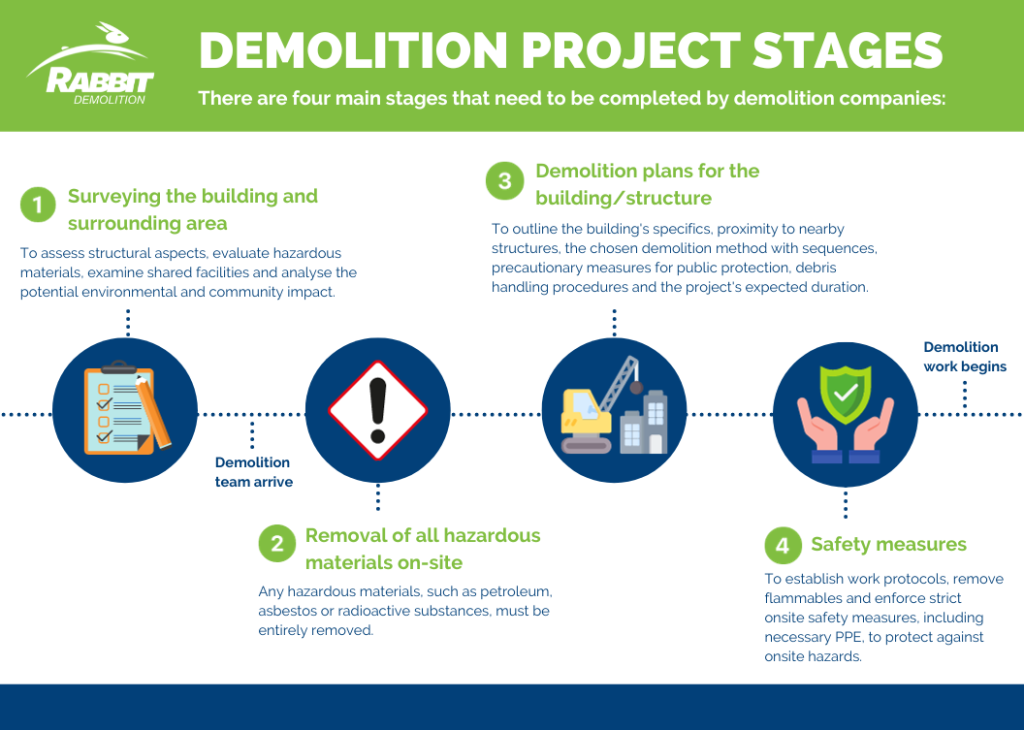Buildings and structures are demolished for a variety of reasons and to ensure the project is carried out by demolition companies safely and efficiently there is usually a standard project framework that should be followed. To get a clearer understanding of what demolition companies need to plan before work begins, we explain the demolition process in more detail.
The types of demolition services that Rabbit Demolition & Excavation Ltd provides are as follows:
Interior Demolition
Interior demolition services involve taking apart the interior portions of a structure while preserving the exterior, usually in preparation for a renovation project. This can include removal of walls, ceilings, pipes, etc.
Selective Demolition
A selective demolition project involves the removal of specific interior or exterior portions of a building while protecting the remaining structure and nearby structures and areas.
Dismantling/Deconstruction
This method involves the careful dismantlement or deconstruction of a structure to preserve components for reuse, recycling, or refurbishment. Dismantling is generally more labour intensive than demolition.
Total Demolition
Total demolition is self-explanatory. It is the demolition of an entire structure and it can be achieved by a number of methods, as listed below.
Mechanical demolition
This type of demolition service is carried out by demolition companies using specialist mechanical equipment and tools. These include hydraulic excavators equipped with specialist attachments that can break concrete and steel, effectively “chewing” the structure apart. Smaller equipment like skid steers, loaders and demolition robots are used for smaller tasks and interior and selective demolition.
Implosion
A highly-specialist type of demolition that employs the use of explosives to bring down high structures by undermining structural supports so that it collapses within its own footprint or along a predetermined path. Implosion is used by demolition companies in less than 1% of demolition projects.
Stages of demolition
There are four main stages that need to be completed by demolition companies on a demolition project. This covers:
- Surveying the building and surrounding area.
- Removal of all hazardous materials on-site.
- Demolition plans for the building/structure.
- Safety measures for everyone working on the project and all parties affected by the works.

Carry out a building survey
Our demolition contractors can organise for a full structural engineers building survey to be carried out if required.
With regard to the presence of asbestos, there are two types of asbestos survey which can be carried out:
- Management of asbestos survey
- Refurbishment & demolition asbestos survey. (This is required by law prior to demolition works).
Building Surveying
To carry out a thorough building survey, the following areas have to checked by demolition companies:
- Materials used to construct the building.
- What the building has been used for prior to demolition.
- Whether hazardous materials including asbestos of all types, toxic chemicals, wastewater, radioactive, flammable or explosive materials are present.
- Condition of the drainage system and if any problems could be posed by flooding, water pollution or erosion.
- How facilities are shared with any nearby buildings, such as partition walls, common staircases etc.
- Nearby traffic and pedestrian conditions.
- Impact dust, vibration, noise and traffic could have on the immediate area.
Structural survey
When it comes to a structural survey, the following processes will be looked at:
- How the building was constructed.
- The structural condition of the basement, underground vaults or underground tanks that may be present.
- The kind of structural system that was used in the design of the building.
- The existing condition of the building.
Remove any hazardous materials onsite
To ensure the health and safety of everyone during the demolition services and throughout the building of the new structure to follow, any hazardous materials found on-site must be completely removed.
If petroleum contamination, asbestos or radioactive metals are identified during the investigation, specialist companies will have to be called in to safely remove these from the site. This may cause some delays to the planned demolition services start date, but no work can begin until the green light has been given by the clearance firm.
Demolition plan
A detailed demolition services plan should lay out the various stages involved, so everyone has a clear understanding of the jobs that have to be completed. The demolition plan should include things such as the:
- Building location.
- Structural support systems featured in the building.
- Distances between the building and surrounding streets, structures, buildings and any street furniture that could potentially be affected.
- Type of demolition to be used and detailed sequences of how the process will be completed.
- Precautionary measures that will be put in place to protect the public. This includes things like covered scaffolding, walkways, protective screens, safety nets, hoardings, catch fans and platforms.
- Processes involved in handling building debris after the demolition has been completed.
- Timeframe needed to complete the demolition.
Safety measures for demolition companies
Before any demolition companies start work, the demolition contractor has to prepare method statements, risk assessments, hold a site induction that details the demolition methods that will be used and discuss the rules of the worksite as a whole. Unless required as part of the demolition process, all flammable goods and items will have to be removed from the site, with any fuels, timber and similar materials put into secure storage.
Fire and emergency protocols will also be in place throughout the duration of the demolition project. Workers will be constantly exposed to things such as chemicals, dust and heat stress, which require suitable measures to be put in place to provide good ventilation, vibration and noise reduction, sanitation and medical and first aid support. All members of the workforce must wear PPE when onsite.
Professional demolition contractors
To find out more about our demolition services, and to arrange a free site visit, get in touch with our friendly team today on 01903 762020, email enquiries@rabbitdemolition.co.uk, or leave us a message here.






